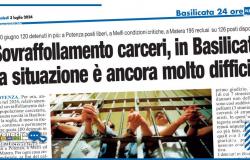Lorenzo Sartorio
Once upon a time, we are not talking about Adam and Eve, but of the early post-war years, certain fruits, such as bananas, were the prerogative of the tables of the rich only, while those who were not rich (and there were really a lot of people who, in those days, things went badly for them) made do with what the plants in the gardens gave in the summer and, in the winter, with what was preserved «in t’al granär». Those were times when the urchins, in the early hours of the afternoon in summer, when the gardeners, overcome by the heat and fatigue, took a nap, made their forays into those green plots geometrically cultivated in the shadow of the ancient walls of the Citadel to gorge on black cherries and cherry tomatoes, the delicious «duròn bjanch e ròss». But there were also ownerless fruits of spontaneous plants that grew here and there in a city outskirts, still countryside, which, little by little, was giving way and… the fields to the city. Ownerless fruits were much sought after by the boys who pounced on those poor plants, plundering them, pulling the branches, or climbing on them like monkeys in search of the most beautiful fruits which, as it happens, were always the most difficult to pick because they were nestled in the highest branches.
The easiest prey, even if it wasn’t fruit, were the dear old «tomàchi» (tomatoes) which could be harvested directly from the plants in those endless fields of via Budellungo delimited by a ditch in which pure water flowed. What a feast and so many stomach aches!! But it was there, as the youth of the past, less vaccinated and less vitaminized than the current one, was probably stronger and more hardened to the elements of life. But what were the summer fruits most appreciated by the boys who, like swarms of bees, took their bicycles to the looting sites? Surely the sharp and thirst-quenching black cherries were a fairly common prey. Another fruit from yesterday that has now disappeared was the «bàricocol», the biricoccolo. A fruit that has its own exciting story told very well in the beautiful book «The ancient fruit of the Parma countryside» by Enzo Melegari for the characters of Tecnografica edizioni Accademia italiana della cucina delegation of Parma. «Its history – observes Melegari – is lost in the mists of time, it is in fact native to Asia, presumably formed between a natural cross between apricot and myrobalan. It was brought to Parma by French gardeners following Duchess Maria Luigia.” In the gardens of stately villas, usually guarded by dogs who did not allow strange intrusions, another much sought-after plant was the jujube with its fruits with white, tender pulp, not very juicy and with a sweet-sour flavor that vaguely recalled that of the date. The best apples, as we know, ripen in autumn, but the kids of the past also hunted for unripe apples or those summer “pomèn” like those of “San Giovanni” and “San Rocco” capable of quenching thirst causing the teeth to “scargnir” (grind). And how can we not mention the very tasty «perèn äd San Zvan», which ripened during the «rozäda». Other fruit, with or without an owner, were «al brùggni», especially the wild ones, but also the more prized ones such as the «zucchelle» which, however, were carefully supervised by the «rezdóre» who collected them to make the traditional jam for their festival cakes.
Many other wild plants were able to give tasty and juicy fruits in those green areas of the city, the scene of youthful forays, like those groves on the Parma embankment at the height of the Ponte Dattaro, in the lowlands of the Cittadella or in those fields of via Torelli that surrounded a “Centrale del Latte” that smelled of the nectar of local cows and of life. Another plant, dear to the memory of many former boys, is the mulberry tree with its white and wine-red “mòr”. Once upon a time, and we really hope we never go back to those times even if the current prospects are not the rosiest, when things went badly for a person, it was said that “al magnäva pan e mòr o pan e sigòlli”, so humble were these two fruits of the earth considered. The “mòr”, for our people, were not the blackberries very common in the mountains, but the mulberry trees, that plant, which many years ago, was widely cultivated in our countryside. Closely linked to silkworm breeding, thanks to its leaves, the mulberry tree was considered a sacred plant by the country people. In this regard, in the 1st volume «Tradizioni Parmigiane» by Enrico Dall’Olio (Grafiche Step editrice) reference is made to the procession of San Marco, on April 25, during which the traditional «rogations» took place crossing the fields. The «rezdóre» also took part in these rites, who, in spring, to earn something, set up the trellises («arèli»), sacrificing the kitchen or the bedroom to raise a quarter or half an ounce of silkworms. Punctually, on the eve of San Marco, the women went to the city to buy the semen of the so-called «cavalèr» to carry it the next day in procession inside a cardboard box with the hope of propitiating the help of heaven on their toil. The little box, after the procession, was placed under the quilt of the bed to encourage the birth of the precious silkworms. Elderly women or those in an advanced state of pregnancy dedicated themselves to the care of the silkworms, in fact it was considered a not very tiring job that even children could attend to, obviously, for the simplest tasks. Therefore, the kitchen, the bedroom and the granary of the peasant house were invaded by the gratings from which, in the silence of the night, came that familiar and almost imperceptible seasonal noise of tireless, voracious, small mouths that nibbled very tender white mulberry leaves.
Various medicinal properties have been attributed to the mulberry, while the wood, not particularly valuable, was used to make agricultural tools or small inlay objects. Like the walnut, which every peasant family could not fail to foresee «äd dardè ca» due to the preciousness of its fruits which were kept for the winter «’n t’al granär», the mulberry too was a victim of superstitions. And, if the mothers did not allow their children to play under a walnut tree, because it was considered an evil plant capable of making the little ones ill with “mäl d’al simjòt” rickets, even those who approached the mulberry tree could run into serious trouble, since they he thought that the plant could attract lightning more than others.
Furthermore, its dialect name «mòr», sounded ominous in many places, evoking death. Other superstitions, however, not only absolved the mulberry tree, but considered it an amulet capable of warding off evil spirits and, therefore, crowns were made of branches which were hung on the walls to protect the house from evil influences. Ancient fruits, now replaced by imported ones and, in any case, not even distant relatives of those that the boys of yesterday, on sunny summer afternoons, plundered from those plants not tormented by herbicides or various poisons, but caressed by the sun, by the air , from the moon and the stars.




